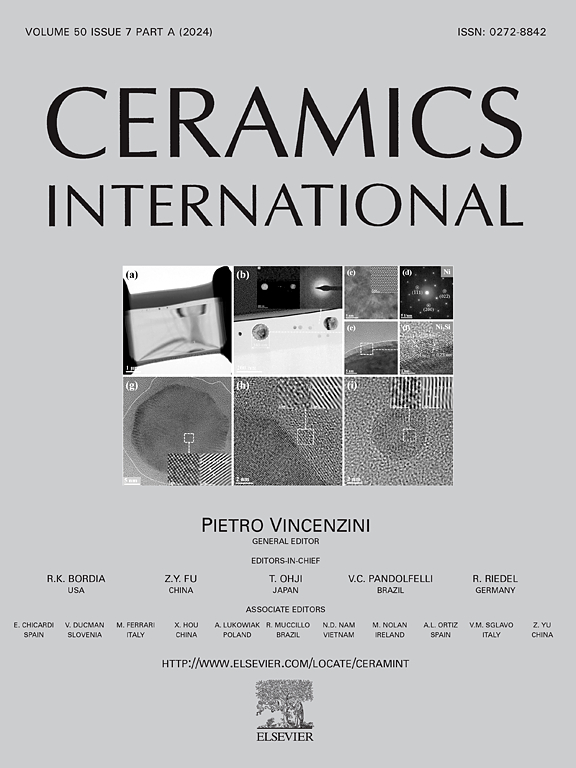SDMG法制备GdBCO-Ag块体超导体的结构与性能
IF 5.6
2区 材料科学
Q1 MATERIALS SCIENCE, CERAMICS
引用次数: 0
摘要
采用单向熔体生长(SDMG)工艺制备了标称成分为70 wt% Gd123 + 30 wt% Gd211 + 10 wt% Ag2O + 0.945 wt% BaCeO3的单晶GdBCO-Ag超导体。显微组织分析表明,在缓慢冷却生长过程中,组织出现了一定的宏观不均匀性。Gd211颗粒的体积分数和孔隙率的体积分数随距离种子的远近而增加,但在a/b平面上基本保持不变。Gd211颗粒宏观分布的不均匀性引起了热膨胀应力,这一点通过Gd211相晶格参数的变化得到了证实。结果还表明,高浓度的Eu从EuBCO种子扩散到样品中。生长结束时样品表面的捕获磁场和悬浮力比生长开始时样品表面的捕获磁场和悬浮力要小。这种现象主要是由于生长末期试样的孔隙率较高造成的。本文章由计算机程序翻译,如有差异,请以英文原文为准。
Microstructure and properties of GdBCO-Ag bulk superconductor prepared by SDMG process
A single-grain GdBCO-Ag superconductor with a nominal composition 70 wt% Gd123 + 30 wt % Gd211 + 10 wt% Ag2O + 0.945 wt% BaCeO3 was prepared by the Single-Direction Melt-Growth (SDMG) process. Microstructure analysis showed that some macroscopic inhomogeneity of the structure developed during slow cooling growth. The volume fraction of Gd211 particles as well as the volume fraction of porosity increase with distance from the seed, but are almost constant along the a/b-plane. The inhomogeneous macroscopic distribution of Gd211 particles induces thermal dilatational stresses, which were confirmed by changes in the lattice parameters of the Gd211 phase. It is also shown that a high concentration of Eu is diffused from the EuBCO seed into the sample. The trapped magnetic field and the levitation force are lower on the sample surface at the end of growth than on the sample surface at the beginning of growth. This phenomenon is mainly caused by the higher porosity of the sample at the end of growth.
求助全文
通过发布文献求助,成功后即可免费获取论文全文。
去求助
来源期刊

Ceramics International
工程技术-材料科学:硅酸盐
CiteScore
9.40
自引率
15.40%
发文量
4558
审稿时长
25 days
期刊介绍:
Ceramics International covers the science of advanced ceramic materials. The journal encourages contributions that demonstrate how an understanding of the basic chemical and physical phenomena may direct materials design and stimulate ideas for new or improved processing techniques, in order to obtain materials with desired structural features and properties.
Ceramics International covers oxide and non-oxide ceramics, functional glasses, glass ceramics, amorphous inorganic non-metallic materials (and their combinations with metal and organic materials), in the form of particulates, dense or porous bodies, thin/thick films and laminated, graded and composite structures. Process related topics such as ceramic-ceramic joints or joining ceramics with dissimilar materials, as well as surface finishing and conditioning are also covered. Besides traditional processing techniques, manufacturing routes of interest include innovative procedures benefiting from externally applied stresses, electromagnetic fields and energetic beams, as well as top-down and self-assembly nanotechnology approaches. In addition, the journal welcomes submissions on bio-inspired and bio-enabled materials designs, experimentally validated multi scale modelling and simulation for materials design, and the use of the most advanced chemical and physical characterization techniques of structure, properties and behaviour.
Technologically relevant low-dimensional systems are a particular focus of Ceramics International. These include 0, 1 and 2-D nanomaterials (also covering CNTs, graphene and related materials, and diamond-like carbons), their nanocomposites, as well as nano-hybrids and hierarchical multifunctional nanostructures that might integrate molecular, biological and electronic components.
 求助内容:
求助内容: 应助结果提醒方式:
应助结果提醒方式:


